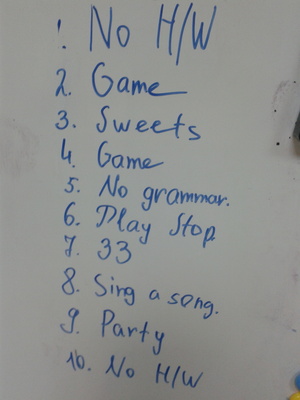
What is a lesson plan?
It is not a lesson plan in a traditional meaning of the word, that is, a set of notes, more or less formal, that a teacher writes in order to prepare the activities for the lesson. It is a list of stages of the lesson, displayed on the board, written both for the teacher and for the students.
The photo that you can see above as the illustration to this post is my primary students’ take on the said plan, prepared for me one of these days, before the lesson. With a clear signal as regards the activities that they would really (really) be involved in. No homework whatsoever, no grammar, either, three games and a party…I have absolutely NO idea what this mysterious ’33’ was supposed to be…
Why do we need it?
For the teacher, it is a lesson in a nutshell, always there, always on display, a clear presentation of all the main stages of the lesson.
For the students, it is a lesson in a nutshell, always there, an overview of what to expect on the day. It serves as a classroom management tool as it helps the kids get a better idea of the lesson. This is how we keep track of the lesson proceedings as we go through it. This is how you can reward the students if you include a story or a game in it. Naturally, the game (at number 9) can happen ONLY if we go through numbers 1 through to 8 first.
The lesson plan also contains some opportunities as regards the students’ taking control of the lesson as they can be involved in erasing the stages that have been completed, after having confirmed that with the teacher, and, in some cases and to some extent, also the opportunity to choose the order of activities, when and if that is appropriate.
In case of the longer lessons, those that last two or even three academic hours, it is a great tool that helps the students manage their time, attention and focus throughout the lesson, the number of activities, the break and so on.
How to do it?
There are always ten points, regardless of how long the lesson is and #1 is almost always ‘Hello. Homework’ and #10 is almost always ‘Bye-bye. Homework’. Anything that I plan for the lesson has to fit in, in the remaining eight numbers.
This has got a lot to do with the fact that I personally like the ten sections in a lesson (and 10 is better than 12 and definitely better than 11) but it also helps the kids see the lesson as a whole, divided into the same number of sections, every single day. It also gives me an incentive to pack the lesson nicely into ten sections and, in turn, that means that they all might have a different length. It is never ‘the lesson time divided by ten’. Sometimes, half-way through the lesson we might be done only at number 2, sometimes we go through numbers 1 – 8 very quickly and what is left is only number 9 – a whole project planned for sixty minutes, for example.
As soon as we are done with a stage, we erase it off the board, moving towards number ten as the lesson progresses. Sometimes I do it, sometimes the students help. I noticed that they are paying attention, reminding me to erase a stage, checking whether we have already finished it or not yet, making sure that I have included the break or the game or the homework.
With my older kids, I try to be tricky and the names for the stages are very rarely revealing or direct. The only thing that I am always open about is the grammar introduction and practice and it normally features on the plan as: ‘Grrrr’. Everything else is as vague and random as possible. Another trick that helps the kids to manage the time and the attention. With the older students who take part in the decision making process as regards ‘What’s next?’ (or with the younger ones, when they are invited to choose), the students have to ask about the stages that interest them most and then make a decision.
Who is it for?
I use the plan for most of my classes, including the teacher training sessions for my teachers. With pres-schoolers, we use only elements of it and most of the time it is limited to annoucing ‘a surprise’ which, with time, began to translate ‘anything new’, ‘anything special’, ‘anything out of the ordinary’ and the kids were asking how many of these surprises I had, whether they were big or small and so on. I
I also try to get my youngest students ready for managing the time of the lesson by introducing stages for parts of the lesson. These of course have to be worded in a very careful way, using only the simple and familiar words and I always count the number of these stages on my fingers. This comes in handy at the end of the lesson, when the kids are already a bit more tired and less focused or, also, during the more complex craft activities. For example, at the end of the lesson, I can say: ‘We need to do ‘story’ (the thumb), ‘game’ (the index finger), ‘the homework’ (the middle finger), ‘Bye-bye song’ (the ring finger) and ‘stickers’ (the pinky). Then, we also check how many of these five we have got left. This really helps the kids to focus, even the youngest ones.
With my primary students, as soon as the kids are able to read, I start putting the plan on the board. I do it before the lesson and we read it together. Again, since they are only learning to manage the written word, I put only single words or even symbols. These may become more complex as the kids grow older.
Happy teaching!